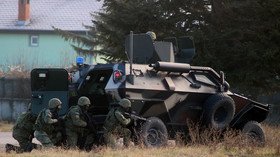Australia hates accepting refugees, but appears to love creating them
Australia has for years employed a deterrence policy to disincentivize refugees from reaching its shores. However, a new report has found Canberra has played a major hand in creating the very asylum-seekers it despises.
Just last week, Australian Broadcasting Corporation (ABC) released a bombshell report that showed the Australian government had approved the export of dozens of shipments of military equipment to the Saudi-led coalition, currently wreaking a deadly war of aggression in Yemen, the poorest, most impoverished nation in the Arab world.
According to the report, Internal Defence Department documents, obtained under Freedom of information (FOI) requests, and from parliamentary hearings, have revealed that the government granted at least 37 export permits for military equipment to the United Arab Emirates (UAE), and 20 to Saudi Arabia.
In January this year, Canberra also announced it was seeking to become one of the world’s top ten arms exporters, unveiling a new loan scheme for defence companies who are willing to sell Australian products overseas. Before this, Australian defense exports amounted to about $2 billion a year, apparently a figure too low for the government as it is presently only the world’s 20th largest arms exporter.
Australia projects it will spend $200 million between now and 2028 in order to reach that goal. At the time of its announcement, Australia’s Defence Industry Minister said that Australia would focus on boosting exports to its allies within the Five Eyes Alliance which includes New Zealand, Canada, the United States and the United Kingdom.
If ABC’s recent report is anything to go by, however, it appears that Australia has found a much more lucrative arms market in the Middle East.
This year, Australia has contributed a mere $23 million in humanitarian assistance to Yemen. This is in comparison to more than $33 million in performance bonds that the government’s export credit agency has provided Electro Optic Systems (EOS), a rising Australian defence and space technology company. EOS is allegedly selling high-powered weapons systems to the UAE, a country whose role in the Yemen war has largely been masked by the mainstream media.
Saudi Arabia and the UAE’s long list of war crimes in Yemen has been public information for years. Almost two years ago, Reuters obtained a report written by a panel of UN experts who advised the UN Security Council that a number of the Saudi-led coalition’s attacks in Yemen “may amount to war crimes.” The experts investigated ten coalition air strikes between March and October in 2016 which killed over 292 civilians, including some 100 women and children.
“In eight of the 10 investigations, the panel found no evidence that the air strikes had targeted legitimate military objectives,” the experts wrote. “For all 10 investigations, the panel considers it almost certain that the coalition did not meet international humanitarian law requirements of proportionality and precautions in attack… The panel considers that some of the attacks may amount to war crimes.”
The coalition has been accused of using banned munitions, including British-made cluster bombs. The beneficiaries of Australia’s slowly but surely expanding arms market have blatantly attacked hundreds of hospitals, including MSF-run (Doctors Without Borders) hospitals. The coalition has hit funerals, wedding parties, factories, agricultural land, refugee camps, residential areas, food trucks, schools and school buses.
One such Saudi-led attack, targeting a wedding procession killed at least ten women in a single bombardment.
The reasons for this indiscriminate, incompetent and criminal aerial campaign have been known even to US military officials for years. As the New York Times reported:
“The first problem was the ability of Saudi pilots, who were inexperienced in flying missions over Yemen and fearful of enemy ground fire. As a result, they flew at high altitudes to avoid the threat below. But flying high also reduced the accuracy of their bombing and increased civilian casualties, US officials said.
“American advisers suggested how the pilots could safely fly lower, among other tactics. But the airstrikes still landed on markets, homes, hospitals, factories and ports, and are responsible for the majority of the 3,000 civilian deaths during the yearlong war, according to the United Nations.”
Even during the recently cemented ceasefire, Saudi air strikes have continued in Hodeidah, the port in which Yemen relies on for most of its imported aid. In August 2015, a series of air strikes destroyed all of the cranes used to unload container ships at this commercial port, and destroyed an entire World Food Program warehouse.
If the Saudi-led coalition was unleashing such an extreme level of havoc as early as 2015, there is no excuse for continuing to sell the coalition arms and equipment in 2018 onwards.
The Saudi-led blockade, including its relentless attacks on Yemen’s major port, has strangled more than 15 million of Yemen’s residents to the point of starvation, killing at least 85,000 children under the age of five in the last three years alone.
All in all, the war in Yemen has created over 2 million internally displaced persons, according to the United Nations High Commissioner for Refugees (UNHCR). Between December 2017 and June 2018, 112,000 Yemeni individuals became newly displaced. All in all, over 3 million Yemenis have fled their homes. In 2017 alone, Oman was forced to host 50,000 asylum-seekers from refugees.
There are over 68 million displaced people in the world, according to the UNHCR. Out of this monumental figure, every year, Australia, with its sizeable land mass and abundant resources, resettles between 13,000 and 19,000 refugees a year.
Also on rt.com Life in fear: Report says 1 in 3 US drone-strike deaths in Yemen are civilians, including childrenAustralia has a firm deterrence policy when it comes to asylum seekers and refugees. It has essentially outsourced its asylum-seeking process to Nauru and Manus Island, where migrants are being left to rot in conditions that are, to put it bluntly, completely inhumane.
According to a recent MSF report, the mental health situation for Nauruan and refugee patients is as bad as torture victims, showing similar levels of mental illness far worse than other MSF projects seen around the world.
MSF also found that the separation of families, which Australia continues to engage in, contributes highly to suicide attempts by refugee patients.
Australia’s shameful treatment of vulnerable asylum seekers will most likely remain more or less in tact in the wake of its efforts to expand its arms trade. Australia’s current Prime Minister, Scott Morrison, (who, by the way, was the former immigration and border protection minister, responsible for the “stop the boats” asylum-seeker policy) has shown some willingness to appear as though he is addressing the issue by the end of this year.
In practice, this strategy will most likely involve accepting New Zealand’s offer to take in about 150 of these asylum-seekers a year.
Even then, Australia is likely to pass a legislative ban to prevent those same asylum-seekers from returning to Australia, even after they have successfully relocated to New Zealand.
Some of these asylum seekers have been left on these islands for up to five years. Even young children have been denied transfer from Nauru to Australia for crucial medical treatment by the current prime minister, simply again for this reason of deterrence: it is better to disincentivize other sick and dying children to try to migrate to Australia’s shores, rather than treat those people who urgently need it.
It took an Australian federal court to force the transfer of these children in urgent need of medical attention, as the government spends hundreds of thousands of dollars fighting these transfers in courts (would it not be cheaper and less time-consuming to just honour your obligations under the Refugee Convention?).
And for that matter, if Australia really does not want to help those people in need and is going to be quite open about its blatant disregard for human rights, it needs to seriously stop its humanitarian façade when it comes to the geopolitical opportunities that present itself elsewhere in the Middle East.
Australia has long-talked about its “moral obligation” to join the US-led fight against Islamic State (IS, formerly ISIS) in Syria (what is the legal basis for Western forces to be in Syria at all?); and yet if a genuine refugee was fleeing an IS insurgency, he or she would be shipped off to Nauru, completely forgotten, without urgent medical care for up to five years at a time.
Talk about moral obligations. In fact, Australian warplanes were involved in an extensive attack on Syrian government troops (who were actually engaged in a fight against IS) in September 2016, under the careful watch of peace-prize laureate Barack Obama.
What is the legal basis for Australia to attack the troops of another foreign country? And why did it attack the troops who were fighting against IS?
Not to mention that Australia’s military equipment and support for Indonesia has helped enable a “slow-motion genocide” in West Papua, a conflict which has killed at least 500,000 Papuans.
For a country that hates refugees, Australia could quite simply stop creating them. For every bomb dropped, every starvation strategy enabled, and every criminal act left unpunished is a displaced person on the other side inching closer to your shores.
It is also quite telling that at the end of the day, the only migrants Australia has genuinely held a helping hand to were white South African land-owners escaping what some have questionably dubbed a “white genocide.” I suppose we shouldn’t be surprised, Australia was basically founded on this type of mass human mistreatment and racism. It would appear that nothing much has changed.
Think your friends would be interested? Share this story!
Subscribe to RT newsletter to get stories the mainstream media won’t tell you.
The statements, views and opinions expressed in this column are solely those of the author and do not necessarily represent those of RT.















